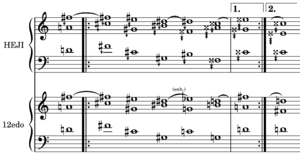Diaschisma
| Interval information |
Sagugu comma
reduced subharmonic
2048/2025, the diaschisma, a comma of 19.553 cents, is the size of a pythagorean comma minus two schismas, from which it derives its name. It may also be defined as the difference between four just perfect fifths plus two just major thirds and three octaves, the difference between a Pythagorean minor seventh (16/9) and a just augmented sixth (225/128), as the difference between two classic diatonic semitones (16/15) and the major whole tone (9/8), that is, (16/15)2/(9/8), or as the difference between the 5-limit tritone 45/32 and its octave complement 64/45.
Temperaments
Tempering it out leads to the diaschismic family of temperaments. See Diaschismic family for the rank-2 temperament family where it is tempered out, especially Srutal archagall which takes advantage of this comma's relation to 256/255 and 289/288 to make it as efficient and natural as possible. See Diaschismic rank-3 family for the rank-3 temperament family where it is tempered out.
Significance
Pařízek's diaschisma pump play xenpaper – a comma pump progression that requires the diaschisma to be tempered out (i.e. equates two notes that are separated by a diaschisma).

In the progression, the bassline moves as follows:
D (up 5/4) F# (down 4/3) C# (down 4/3) G# (up 5/4) C (down 4/3) G (up 3/2) D (*).
If we ignore octaves,
- the first three steps (cumulatively D to G#) moves us up by the tritone 45/32;
- the last three steps (cumulatively G# to D) are the same moves as the first three, moving up by the tritone 45/32 a second time.
In pure JI, since 45/32 is flat of 600c, each cycle of this progression (*) would shift the tonic down by the diaschisma, which is (2/1) / (45/32)2 = 2048/2025. The fact that the D we come back to is exactly the same as the first D, indicates that that their difference, the diaschisma, is tempered out. To carry out this tempering-out (assuming octaves are kept pure), the basic 5-limit intervals, 5/4 and 3/2, are adjusted, or tempered, such that a stack of two 45/32 tritones is sharpened up to the octave 2/1.
This also tells us that if a system tempers out the diaschisma, it has an interval that is equal to exactly half of an octave‚ namely the tempered 45/32 tritone. Thus all edos (such as 12edo, 22edo, 34edo and 46edo) and mos scale structures (such as the mos scales of diaschismic and pajara) that temper out the diaschisma split the octave into two equal parts; in particular, all diaschismic edos are even-numbered edos.
Etymology
The modern sense of the term is due to Hermann von Helmholtz and Alexander John Ellis in 1875 when the English translation of Sensations of Tone was first published.
2048/2025 was earlier referred to as the diminished comma and comma minor by Jean-Philippe Rameau (1683-1764). However in modern (1875 onwards) music theory the term diaschisma is almost always used.
There have been other intervals besides 2048/2025 that were called diaschisma in the Ancient Greek, Roman and medieval periods, however those alternate meanings of the word fell out of use centuries ago.
